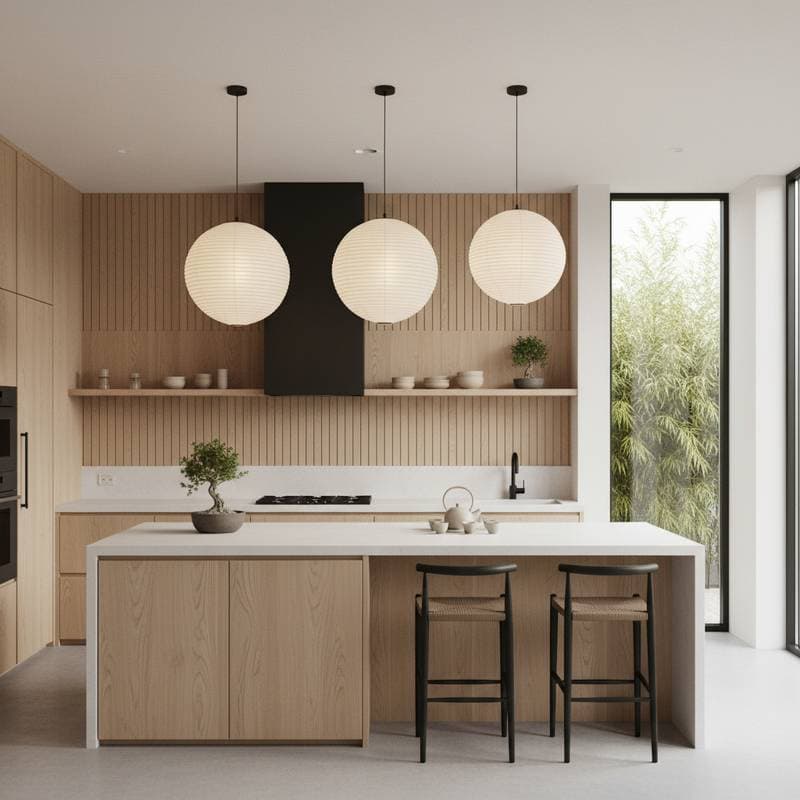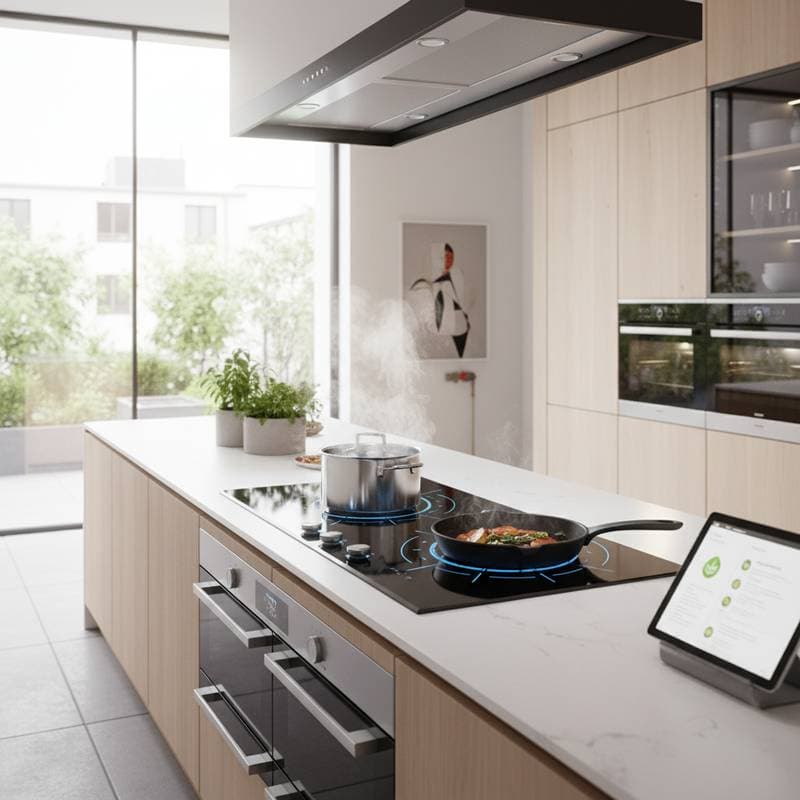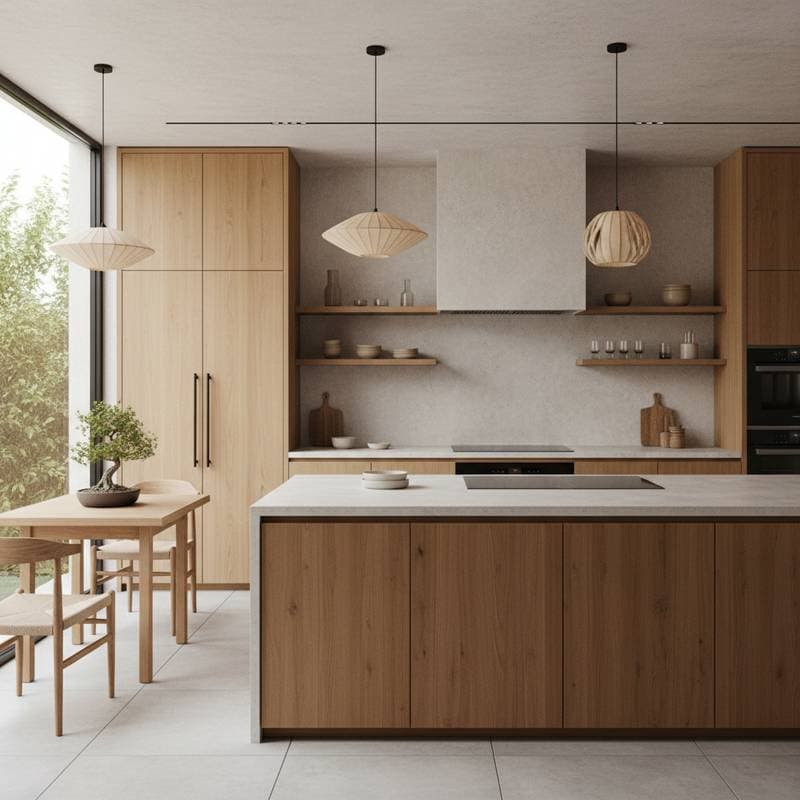Japandi Kitchens: Warmth Transforms Minimalist Style
A clean, modern kitchen offers simplicity and elegance, yet stark lines and neutral palettes often evoke a sense of detachment. Such spaces prioritize form and function but may overlook the nurturing quality that defines a home's core. Japandi design addresses this by merging Japanese minimalism with Scandinavian warmth, resulting in kitchens that radiate tranquility and hospitality.
The Challenge of Cold Minimalism
Minimalist kitchens feature streamlined cabinetry, concealed appliances, and open layouts that facilitate maintenance and endure trends. These elements promote efficiency and a polished aesthetic. However, the absence of tactile warmth can render the space impersonal, prompting visitors to admire from afar rather than settle in comfortably.
The Japandi Solution
Japandi achieves equilibrium through deliberate fusion. Japanese influences contribute restraint and clarity, while Scandinavian principles introduce softness and approachability. This approach favors subdued earth tones, organic woods, and textured finishes over high-gloss surfaces and stark whites, yielding organized yet vibrant environments.
Essential features of a Japandi kitchen encompass:
- Natural materials such as oak planks, birch panels, bamboo accents, and quarried stone for authentic, grounding presence.
- Neutral color schemes featuring creams, taupes, warm clays, and subtle charcoals to evoke calm without overwhelming.
- Purposeful functionality where each item serves a role, eliminating excess while supporting daily routines.
- Ambient lighting that tempers harshness and highlights material nuances through layered sources.
Step-by-Step Design Implementation
-
Establish the base structure. Opt for matte-finish cabinetry in untreated wood grains or low-sheen paints. Greige undertones or light walnut stains provide versatile warmth that complements varied lighting conditions.
-
Incorporate varied textures. Balance sleek elements with organic ones, such as pairing polished quartz counters with artisanal clay backsplashes or linen-upholstered stools. These contrasts add subtle dimension and tactile appeal without disrupting harmony.
-
Choose understated hardware. Select narrow profiles in matte black or satin brass for pulls and knobs. Integrated push mechanisms enhance seamlessness, maintaining focus on the overall composition.
-
Implement multi-level lighting. Install recessed ceiling fixtures for broad illumination, supplemented by LED strips beneath cabinets and pendant lamps over islands. Employ 2700K warm-white bulbs to accentuate wood grains and soften shadows.
-
Introduce living accents. Position items like olive wood utensils, cotton aprons, or low-maintenance succulents on open shelves. These elements infuse vitality while adhering to minimal principles.
-
Curate sparse adornments. Limit to select pieces with intentional placement, such as a single hand-thrown pottery vessel or woven basket. This restraint fosters serenity and prevents visual overload.
Key Practical Factors
Budget Breakdown: Japandi adaptations scale to financial constraints.
-
Affordable updates: Sand and refinish cabinets with eco-friendly stains, then integrate affordable LED lighting. Budgets range from $1,500 to $4,000 for materials and basic tools.
-
Moderate overhauls: Swap surfaces for engineered quartz or recycled wood composites and install semi-custom cabinets in birch. Costs generally fall between $8,000 and $20,000, including labor.
-
Luxury transformations: Commission bespoke joinery, imported slate flooring, and artisan fixtures. Investments often exceed $25,000, prioritizing sustainability and longevity.
Regulatory and Safety Aspects: Surface-level modifications seldom require approvals, but alterations to plumbing or electrics demand compliance with municipal regulations. Engage certified contractors for any work involving utilities to ensure code adherence and hazard prevention.
Project Timelines: Cosmetic refreshes conclude in approximately one week, allowing for drying times. Comprehensive renovations span three to six weeks, factoring in custom milling and installation schedules.
Embracing Daily Use in a Japandi Kitchen
Beyond aesthetics, Japandi promotes intentional habits that enhance well-being. Designated storage solutions naturally minimize accumulation, streamlining preparation and cleanup. The inherent balance of form and comfort cultivates a grounded ambiance, ideal for shared meals or quiet reflection.
Preserve the design's integrity with pH-neutral cleaners on wood and stone, avoiding abrasives that dull finishes. Rotate seasonal textiles, such as woven placemats or herbal bundles, to sustain freshness and adaptability.
Initiating Your Japandi Transformation
Commence with incremental changes to build confidence. Substitute cool-toned bulbs for warmer alternatives, introduce a single wooden tray for organization, and declutter surfaces methodically. These adjustments reveal the style's potential swiftly.
Japandi thrives on measured integration of simplicity and solace. Attain this equilibrium, and the kitchen evolves into a versatile sanctuary that supports productivity while offering respite from daily demands.








